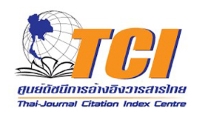JOURNAL DETAIL
Applications of Oxidized Chitosan for Scale Prevention in Sugar Evaporators
Paper Type |
Contributed Paper |
Title |
Applications of Oxidized Chitosan for Scale Prevention in Sugar Evaporators |
Author |
Tu Phuong Pham Le and Wanwipa Siriwatwechakul* |
Email |
wanwipa@siit.tu.ac.th |
|
Abstract: This study explores the potential use of oxidized chitosan (O.C) as an antiscalant for calcium oxalate (CaOx) and calcium sulfate (CaSO4), which are the main components of scales during sugar processing. Chitosan was selectively oxidized by NaClO/NaBr/TEMPO at pH 10.8 and 30 °C following the procedure by Yoo et al. [1]. The products have oxidation degrees ranging from 31 % to 77 % (by conductivity titration). The antiscaling performance of the O.C. was observed in comparison with a commercial antiscalant, Acumer1050, at the same antiscalant concentration (10 ppm) for two types of scales: CaOx and CaSO4. For CaOx scales, the O.C with 77 % degree of oxidation (O.C-77) shows the highest inhibition (72 %), whereas Acumer1050 and O.C-31 exhibit similar percent inhibition, 46 % and 36 %, respectively. However, in the presence of 13 % sugar (w/v), O.C-77 experiences a dramatic drop in performance to 30 % inhibition, but Acumer1050 only slightly decreases to 40 %. For CaSO4 scales, the results also show that the higher the oxidation degree, the better the antiscaling performance, with O.C-77 showing the highest percent inhibition (80 %) in aqueous solution, whereas Acumer1050 shows the best performance with 90 % inhibition. In 15 % sugar (w/v), the performance slightly drops to 75 % for Acumer1050 and 62 % for O.C-77. For CaOx, sugar strongly affects antiscaling performance of the high molecular weight O.C (O.C HMW), whereas the low molecular weight O.C (O.C LMW) shows consistent performance with increasing sugar concentration. For CaSO4, O.C HMW exhibits better performance, although for both, antiscaling performance is reduced with increasing sugar concentration. The different antiscaling performance may come from the different antiscaling mechanisms involved for CaOx and CaSO4. The results from SEM and XRD suggest that O.C binds with calcium ions to form a metal ion-polymer complex to prevent CaOx scales. On the other hand, O.C prefers to adsorb onto nuclei to prevent CaSO4 crystal growth. The results show that O.C can be a green alternative to the commercial antiscalant from a petroleum-based product. |
|
Start & End Page |
961 - 972 |
Received Date |
2016-07-04 |
Revised Date |
|
Accepted Date |
2016-11-13 |
Full Text |
Download |
Keyword |
Oxidized chitosan, TEMPO, oxidation, calcium oxalate, calcium sulfate, bio-based antiscalants, sugar processing |
Volume |
Vol.45 No.2 (March 2018) |
DOI |
|
Citation |
Le T.P.P. and Siriwatwechakul* W., Applications of Oxidized Chitosan for Scale Prevention in Sugar Evaporators, Chiang Mai Journal of Science, 2018; 45(2): 961-972. |
| View:909 Download:357 | |
RELATED ARTICLE
Short-Term Heat Load Forecasting Based on CEEMD and a Hybrid IDBO-TCN-BiGRU Network
Article ID: e2025032
Author:Zhang Lu and Xue Guijun
Vol.52 No.3 (May 2025) View: 610 Download:254
Article ID: e2025032
Author:Zhang Lu and Xue Guijun
Vol.52 No.3 (May 2025) View: 610 Download:254
Exploring Microbiota and Metabolome Dynamics During the Production of Dried Salted Mackerel (Pneumatophorus japonicus)
Article ID: e2025022
Author:Mingjia Yu, Jiannan Liu, Xiaobo Wang, Ming Qi and Minfu Wu
Vol.52 No.2 (March 2025) View: 619 Download:295
Article ID: e2025022
Author:Mingjia Yu, Jiannan Liu, Xiaobo Wang, Ming Qi and Minfu Wu
Vol.52 No.2 (March 2025) View: 619 Download:295
Anatomical Characteristics of Leaf and Petiole and Presence of Calcium Oxalate Crystals in Giant Elephant Ear (Colocasia gigantea (Blume) Hook. f.)
Article ID: e2025016
Author:Yupadee Paopun, Piyanan Thanomchat and Nustsaba Kronburee
Vol.52 No.2 (March 2025) View: 592 Download:236
Article ID: e2025016
Author:Yupadee Paopun, Piyanan Thanomchat and Nustsaba Kronburee
Vol.52 No.2 (March 2025) View: 592 Download:236
Spatio-temporal Prediction of Air Quality Using Spatio-temporal Clustering and Hierarchical Bayesian Model
Article ID: e2024083
Author:Feiyun Wang, Yao Hu and Yutao Qin
Vol.51 No.5 (September 2024) View: 795 Download:359
Article ID: e2024083
Author:Feiyun Wang, Yao Hu and Yutao Qin
Vol.51 No.5 (September 2024) View: 795 Download:359
Formation of High Hardness ZnO/Cu Nanocomposite by Thermal Oxidation from Cu-Zn Alloy Strips
Article ID: e2024045
Author:Minh-Tan Ha, Pham Mai Khanh and Nguyen Hong Hai
Vol.51 No.3 (May 2024) View: 837 Download:660
Article ID: e2024045
Author:Minh-Tan Ha, Pham Mai Khanh and Nguyen Hong Hai
Vol.51 No.3 (May 2024) View: 837 Download:660
Liquid Phase Styrene Epoxidation Catalyzed by Rice Husk Ash Silica Derived Mesoporous Calcium Silicate and Calcite-type Calcium Carbonate Catalyst
page: 611 - 630
Author:Anwar Iqbal*, Kok-Hou Tan, Farook Adam, Noor Hana Hanif Abu Bakar, Mohammad Norazmi Ahmad and Muhammad Rahimi Yusop*
Vol.48 No.2 (March 2021) View: 1,481 Download:658
page: 611 - 630
Author:Anwar Iqbal*, Kok-Hou Tan, Farook Adam, Noor Hana Hanif Abu Bakar, Mohammad Norazmi Ahmad and Muhammad Rahimi Yusop*
Vol.48 No.2 (March 2021) View: 1,481 Download:658
Synthesis of Porous Cobalt Doped Titania-Silica by Using Cattail Leaves as Template and its Catalytic Oxidation of Tertralin
page: 207 - 220
Author:Zhongbiao Zhai, Yingchun Miao*, Shanshan Yang, Yachong Yang, Jing Chen, Gang Xie and Shixiong Wang
Vol.48 No.1 (January 2021) View: 978 Download:353
page: 207 - 220
Author:Zhongbiao Zhai, Yingchun Miao*, Shanshan Yang, Yachong Yang, Jing Chen, Gang Xie and Shixiong Wang
Vol.48 No.1 (January 2021) View: 978 Download:353
Transformation of Lignin Model Compound and Lignin by Graphene Oxide Immobilized Laccase
page: 176 - 184
Author:Xue-Fei Zhou*
Vol.48 No.1 (January 2021) View: 938 Download:513
page: 176 - 184
Author:Xue-Fei Zhou*
Vol.48 No.1 (January 2021) View: 938 Download:513
Biomimetic One-Pot Mediated Oxygenolysis of Dibenzodioxocin Lignin Model and Organosolv Lignin Using M([H4]salen) Complexes
page: 1230 - 1240
Author:Xue-Fei Zhou
Vol.47 No.6 (November 2020) View: 820 Download:257
page: 1230 - 1240
Author:Xue-Fei Zhou
Vol.47 No.6 (November 2020) View: 820 Download:257
Catalytic Activity of Bimetallic Au@Pt Core-Shell Over CeO2-Al2O3 for CO Oxidation Reaction
page: 278 - 287
Author:Wichet Lamai and Akkarat Wongkaew*
Vol.47 No.2 (Special Issue I : March 2020) View: 1,732 Download:880
page: 278 - 287
Author:Wichet Lamai and Akkarat Wongkaew*
Vol.47 No.2 (Special Issue I : March 2020) View: 1,732 Download:880
Factors Affecting Phytoplankton Removal by Electro-Oxidation of Artificial Seawater
page: 255 - 259
Author:Niwooti Whangchai*, Nakao Nomura and Masatoshi Matsumura
Vol.30 No.3 (DECEMBER 2003) View: 797 Download:246
page: 255 - 259
Author:Niwooti Whangchai*, Nakao Nomura and Masatoshi Matsumura
Vol.30 No.3 (DECEMBER 2003) View: 797 Download:246
Enhanced Growth and Ethanol Oxidation by Overexpressed caiA Gene Encoding acyl-CoA Dehydrogenase in Komagataeibacter
medellinensis NBRC 3288
page: 196 - 206
Author:Phisurang Konjanda, Toshiharu Yakushi, Kazunobu Matsushita and Gunjana Theeragool
Vol.46 No.2 (March 2019) View: 962 Download:333
page: 196 - 206
Author:Phisurang Konjanda, Toshiharu Yakushi, Kazunobu Matsushita and Gunjana Theeragool
Vol.46 No.2 (March 2019) View: 962 Download:333
Photocatalysis Using Titanium Dioxide for Treatment of Textile Wastewater Containing Disperse Dyes
page: 2730 - 2739
Author:Shumaila Kiran, Sofia Nosheen, Sarosh Iqbal, Shazia Abrar, Fatima Jalal, Tahsin Gulzar, Ammara Mukhtar, Shumaila Maqsood, Waqas Ahmad and Nabigha Naseer
Vol.45 NO.7 (November 2018) View: 879 Download:307
page: 2730 - 2739
Author:Shumaila Kiran, Sofia Nosheen, Sarosh Iqbal, Shazia Abrar, Fatima Jalal, Tahsin Gulzar, Ammara Mukhtar, Shumaila Maqsood, Waqas Ahmad and Nabigha Naseer
Vol.45 NO.7 (November 2018) View: 879 Download:307
Phytochemical Investigation and Antioxidant Properties of Different Extracts from Artabotrys harmandii Finet & Gagnep
page: 2338 - 2347
Author:Wararut Bunchareon, Supaporn Pamok, Supap Saenphet and Kanokporn Saenphet
Vol.45 No.6 (September 2018) View: 995 Download:436
page: 2338 - 2347
Author:Wararut Bunchareon, Supaporn Pamok, Supap Saenphet and Kanokporn Saenphet
Vol.45 No.6 (September 2018) View: 995 Download:436
Synthesis and Characterization of Mechanochemically Synthesized Cobalt Oxide and Evaluation of its Catalytic Performance for Degradation of Congo Red Dye in Aqueous Medium
page: 1901 - 1908
Author:Mohsin Siddique, Mohammad Ilyas and Muhammad Saeed
Vol.45 No.4 (July 2018) View: 966 Download:269
page: 1901 - 1908
Author:Mohsin Siddique, Mohammad Ilyas and Muhammad Saeed
Vol.45 No.4 (July 2018) View: 966 Download:269
Simple Medium Formulation for Manganese Remediation by Green Microalga Pediastrum duplex AARLG060
page: 1247 - 1256
Author:Jakkapong Thongpitak, Jeeraporn Pekkoh and Chayakorn Pumas*
Vol.45 No.3 (May 2018) View: 1,078 Download:313
page: 1247 - 1256
Author:Jakkapong Thongpitak, Jeeraporn Pekkoh and Chayakorn Pumas*
Vol.45 No.3 (May 2018) View: 1,078 Download:313
Iron Reduces Iron: A Spectroelectrochemical Insight of Ligand Effect on Iron Redox Potential
page: 1087 - 1098
Author:Shabnum Bashir, Mohammad Mustafa, Syed Wasim Safvi, Nisar Ahmad Farhad and Masood Ahmad Rizvi*
Vol.45 No.2 (March 2018) View: 875 Download:502
page: 1087 - 1098
Author:Shabnum Bashir, Mohammad Mustafa, Syed Wasim Safvi, Nisar Ahmad Farhad and Masood Ahmad Rizvi*
Vol.45 No.2 (March 2018) View: 875 Download:502
Toluene Oxidation using K-OMS 2 Synthesized Via Hydrothermal Process by Central Composite Design
page: 1030 - 1038
Author:Jessa Marie Millanar, Mark Daniel de Luna, Aummara Yodsa-nga and Kitirote Wantala*
Vol.45 No.2 (March 2018) View: 963 Download:215
page: 1030 - 1038
Author:Jessa Marie Millanar, Mark Daniel de Luna, Aummara Yodsa-nga and Kitirote Wantala*
Vol.45 No.2 (March 2018) View: 963 Download:215
In vitro Antioxidant Evaluation of Wood Vinegars from Carbonization of Wood and Bamboo
page: 868 - 880
Author:Yongyuth Theapparat*, Chanita Ponglimanont, Ausa Chandumpai and Nikhom Laemsak
Vol.45 No.2 (March 2018) View: 863 Download:352
page: 868 - 880
Author:Yongyuth Theapparat*, Chanita Ponglimanont, Ausa Chandumpai and Nikhom Laemsak
Vol.45 No.2 (March 2018) View: 863 Download:352
In vitro Anti-aging Activities of Centotheca lappacea (L) desv. (Ya Repair) Extract
page: 846 - 857
Author:Thavatchai Kamoltham, Jiradej Manosroi, Charinya Chankhampan, Worapaka Manosroi and Aranya Manosroi*
Vol.45 No.2 (March 2018) View: 1,133 Download:683
page: 846 - 857
Author:Thavatchai Kamoltham, Jiradej Manosroi, Charinya Chankhampan, Worapaka Manosroi and Aranya Manosroi*
Vol.45 No.2 (March 2018) View: 1,133 Download:683
Proliferation of Embryogenic Callus of Oil Palm (Elaeis guineensis Jacq.) Using Different Culture Systems and Genetic Instability Assay by Simple Sequence Repeat (SSR) Technique
page: 784 - 796
Author:Stapaporn Kerdsuwan and Sompong Te-chato*
Vol.45 No.2 (March 2018) View: 825 Download:237
page: 784 - 796
Author:Stapaporn Kerdsuwan and Sompong Te-chato*
Vol.45 No.2 (March 2018) View: 825 Download:237
Properties of Plasticized Polylactic Acid Films with Epoxidized Rubber Seed Oil
page: 1591 - 1600
Author:Jutamas Kantee and Somjai Kajorncheappunngam*
Vol.44 No.4 (October 2017) View: 891 Download:363
page: 1591 - 1600
Author:Jutamas Kantee and Somjai Kajorncheappunngam*
Vol.44 No.4 (October 2017) View: 891 Download:363
Total Phenolic and Ascorbic Acid Contents and Antioxidant Activities of Twelve Different Ecotypes
of Phyllanthus emblica from Pakistan
page: 904 - 911
Author:Syed Mubashar Sabir*, Rashad Hussain Shah and Asad Hussain Shah
Vol.44 No.3 (July 2017) View: 953 Download:483
page: 904 - 911
Author:Syed Mubashar Sabir*, Rashad Hussain Shah and Asad Hussain Shah
Vol.44 No.3 (July 2017) View: 953 Download:483
Lipid Peroxidation of Escherichia coli by Triplet Non-thermal Atmospheric Pressure Plasma Jet
page: 678 - 687
Author:A. Hossienzadeh Colagar* [a,b], O. Alavi [a], F. Sohbatzadeh [b, c]
Vol.44 No.2 (April 2017) View: 888 Download:244
page: 678 - 687
Author:A. Hossienzadeh Colagar* [a,b], O. Alavi [a], F. Sohbatzadeh [b, c]
Vol.44 No.2 (April 2017) View: 888 Download:244
Temporal Fuzzy Case-based Reasoning Retrieval
page: 267 - 278
Author:Tawin Tanawong
Vol.44 No.1 (JANUARY 2017) View: 800 Download:274
page: 267 - 278
Author:Tawin Tanawong
Vol.44 No.1 (JANUARY 2017) View: 800 Download:274
Catalytic Oxidation of Glucose with Hydrogen Peroxide and Colloidal Gold as Pseudo-Homogenous Catalyst: A Combined Experimental and Theoretical Investigation
page: 825 - 833
Author:Jitrayut Jitonnom [a] and Christoph Sontag *[a]
Vol.43 No.4 (JULY 2016) View: 882 Download:504
page: 825 - 833
Author:Jitrayut Jitonnom [a] and Christoph Sontag *[a]
Vol.43 No.4 (JULY 2016) View: 882 Download:504
Successive Reduction for Preparation of Various PdxPty-MWCNTs Catalysts for Formic Acid Oxidation
page: 600 - 609
Author:Pitak Wongthep [a], Paralee Waenkaew [a, b], Thapanee Sarakonsri [a, b], Somchai Lapanantnoppakhun [a, c] and Surin Saipanya*[a, b]
Vol.43 No.3 (APRIL 2016) View: 811 Download:473
page: 600 - 609
Author:Pitak Wongthep [a], Paralee Waenkaew [a, b], Thapanee Sarakonsri [a, b], Somchai Lapanantnoppakhun [a, c] and Surin Saipanya*[a, b]
Vol.43 No.3 (APRIL 2016) View: 811 Download:473
Theory of Doping in Indirect Determination of Concentration and Mobility of Native Point Defects in Metal Oxides
page: 365 - 374
Author:Zbigniew Grzesik
Vol.43 No.2 (SPECIAL ISSUE 1) View: 851 Download:257
page: 365 - 374
Author:Zbigniew Grzesik
Vol.43 No.2 (SPECIAL ISSUE 1) View: 851 Download:257
Ameliorating Reactive Oxygen Species-Induced
in vitro Lipid Peroxidation in Liver, Carbohydrate and DNA Damage by Dendrocalamus hamiltonii Different Leaf Extracts
page: 80 - 88
Author:Arvind Kumar Goyal [a,b], Sushil Kumar Middha [c], Talambedu Usha [c] and Arnab Sen*[a]
Vol.43 No.1 (JANUARY 2016) View: 923 Download:227
page: 80 - 88
Author:Arvind Kumar Goyal [a,b], Sushil Kumar Middha [c], Talambedu Usha [c] and Arnab Sen*[a]
Vol.43 No.1 (JANUARY 2016) View: 923 Download:227
Preparation of Pt/ATO Catalysts for Electrocatalysis in Direct Alcohol Fuel Cell
page: 169 - 175
Author:Li Fang *[a], Surin Saipanya *[b,c], Xuemei Luo [a], Xiaoping Huang [a] and Feifei Li [a]
Vol.43 No.1 (JANUARY 2016) View: 858 Download:353
page: 169 - 175
Author:Li Fang *[a], Surin Saipanya *[b,c], Xuemei Luo [a], Xiaoping Huang [a] and Feifei Li [a]
Vol.43 No.1 (JANUARY 2016) View: 858 Download:353
Morphology and Catalytic Activity of Gold Core-Platinum Shell Nanoparticles
page: 481 - 489
Author:Kontee Thongthai, Laongnuan Srisombat, Surin Saipanya and Supon Ananta
Vol.42 No.2 (APRIL 2015) View: 840 Download:271
page: 481 - 489
Author:Kontee Thongthai, Laongnuan Srisombat, Surin Saipanya and Supon Ananta
Vol.42 No.2 (APRIL 2015) View: 840 Download:271
Characteristics of Microstructure, Microhardness, and Oxidation of FSW and MIG Welded Steels
page: 831 - 838
Author:Seul Ki Kim, Seung Boo Jung and Dong Bok Lee*
Vol.40 No.5 SPECIAL ISSUE 1 View: 840 Download:278
page: 831 - 838
Author:Seul Ki Kim, Seung Boo Jung and Dong Bok Lee*
Vol.40 No.5 SPECIAL ISSUE 1 View: 840 Download:278
Antioxidant Potential of Pleurotus porrigens Extract and Application in Sunflower Oil during Accelerated Storage
page: 34 - 48
Author:Hip Seng Yim*[a, b], Fook Yee Chye [b], Mei Lian Liow [a], and Chun Wai Ho [a]
Vol.40 No.1 (JANUARY 2013) View: 968 Download:346
page: 34 - 48
Author:Hip Seng Yim*[a, b], Fook Yee Chye [b], Mei Lian Liow [a], and Chun Wai Ho [a]
Vol.40 No.1 (JANUARY 2013) View: 968 Download:346
In vitro INHIBITION OF LIPID PEROXIDATION AND THE ANTIOXIDANT SYSTEM OF ENDOPHYTIC FUNGI FROM THAI MEDICINAL PLANTS
page: 429 - 444
Author:Teerayut Theantana [a,b], Duangta Kanjanapothi [c], Saisamorn Lumyong* [b]
Vol.39 No.3 (JULY 2012) View: 922 Download:271
page: 429 - 444
Author:Teerayut Theantana [a,b], Duangta Kanjanapothi [c], Saisamorn Lumyong* [b]
Vol.39 No.3 (JULY 2012) View: 922 Download:271
Comparative Analysis of Aqueous Extracts of Amaranth and Coriander in Scavenging Free Radical Activity and Protection of DNA against Oxidative Damage
page: 560 - 571
Author:Asmita Dutta and Mukesh Singh
Vol.38 No.4 (OCTOBER 2011) View: 911 Download:390
page: 560 - 571
Author:Asmita Dutta and Mukesh Singh
Vol.38 No.4 (OCTOBER 2011) View: 911 Download:390
Stability of Vancomycin 31 mg/mL in Extemporaneous Eye Drops Determined with Capillary Electrophoresis
page: 533 - 540
Author:Anutra Khangtragool, Sineenart Santidherakul and Phuriwat Leesawat
Vol.38 No.4 (OCTOBER 2011) View: 970 Download:662
page: 533 - 540
Author:Anutra Khangtragool, Sineenart Santidherakul and Phuriwat Leesawat
Vol.38 No.4 (OCTOBER 2011) View: 970 Download:662
Effect of Solution on Growth of Zinc Oxide Tetrapod
by Thermal Oxidation Technique
page: 187 - 192
Author:Chawalit Bhoomanee, Niyom Hongsith, Ekasiddh Wongrat, Supab Choopun, and Duangmanee Wongratanaphisa
Vol.38 No.2 (APRIL 2011) View: 810 Download:334
page: 187 - 192
Author:Chawalit Bhoomanee, Niyom Hongsith, Ekasiddh Wongrat, Supab Choopun, and Duangmanee Wongratanaphisa
Vol.38 No.2 (APRIL 2011) View: 810 Download:334
Zinc Oxide Whiskers by Thermal Oxidation Method
page: 39 - 46
Author:Kiattipoom Kongjai, Supab Choopun, Niyom Hongsith, Atcharawon Gardchareon
Vol.38 No.1 (JANUARY 2011) View: 852 Download:245
page: 39 - 46
Author:Kiattipoom Kongjai, Supab Choopun, Niyom Hongsith, Atcharawon Gardchareon
Vol.38 No.1 (JANUARY 2011) View: 852 Download:245
Applying of Aluminium Deoxidation in Iron Roll
Casting
page: 196 - 198
Author:Teerapong Harnwirojkul, Mana Polboon, John Pearce and Thanaporn Korad
Vol.35 No.1 (JANUARY 2008) View: 817 Download:327
page: 196 - 198
Author:Teerapong Harnwirojkul, Mana Polboon, John Pearce and Thanaporn Korad
Vol.35 No.1 (JANUARY 2008) View: 817 Download:327
Effect of Cerium Oxide and Zirconium Oxide to
Activity of Catalysts
page: 156 - 162
Author:Akkarat Wongkaew
Vol.35 No.1 (JANUARY 2008) View: 858 Download:422
page: 156 - 162
Author:Akkarat Wongkaew
Vol.35 No.1 (JANUARY 2008) View: 858 Download:422
A New Analytical Expression of the Gas Conversion
for TAP Experiments with Bimodal-Pore-Structure
Catalyst
page: 150 - 155
Author:Wisuthchai Boonwatcharapunsakul and Phungphai Phanawadee
Vol.35 No.1 (JANUARY 2008) View: 808 Download:320
page: 150 - 155
Author:Wisuthchai Boonwatcharapunsakul and Phungphai Phanawadee
Vol.35 No.1 (JANUARY 2008) View: 808 Download:320
Degradation of Congo Red Dye by Ozonation
page: 63 - 68
Author:Thirachitra Tapalad, Arthit Neramittagapong, Sutasinee Neramittagapong and Mallika Boonmee
Vol.35 No.1 (JANUARY 2008) View: 3,588 Download:460
page: 63 - 68
Author:Thirachitra Tapalad, Arthit Neramittagapong, Sutasinee Neramittagapong and Mallika Boonmee
Vol.35 No.1 (JANUARY 2008) View: 3,588 Download:460
Aluminization of High Purity Nickel by Powder Liquid
Coating
page: 331 - 339
Author:Patama Visuttipitukul, Nantiya Limvanutpong, Niti Yongvanich, Prasonk Srichroenchai and Panyawat Wan
Vol.36 No.3 (SEPTEMBER 2009) View: 810 Download:313
page: 331 - 339
Author:Patama Visuttipitukul, Nantiya Limvanutpong, Niti Yongvanich, Prasonk Srichroenchai and Panyawat Wan
Vol.36 No.3 (SEPTEMBER 2009) View: 810 Download:313
Synthesis and Characterisation of Poly(2-hydroxyethyl methacrylate-co-methyl acrylate) Hydrogels for Use as Temporary Skin Substitutes
page: 71 - 82
Author:Tiwaporn Siriwittayakorn [a], Nantarat Suebsanit [a], Robert Molloy [a], Paisit Siriwittayakorn [b] and Malinee Prasitsilp [c]
Vol.28 No.2 (DECEMBER 2001) View: 846 Download:271
page: 71 - 82
Author:Tiwaporn Siriwittayakorn [a], Nantarat Suebsanit [a], Robert Molloy [a], Paisit Siriwittayakorn [b] and Malinee Prasitsilp [c]
Vol.28 No.2 (DECEMBER 2001) View: 846 Download:271
Copyrights © Since 2021 All Rights Reserved by Chiang Mai Journal of Science










